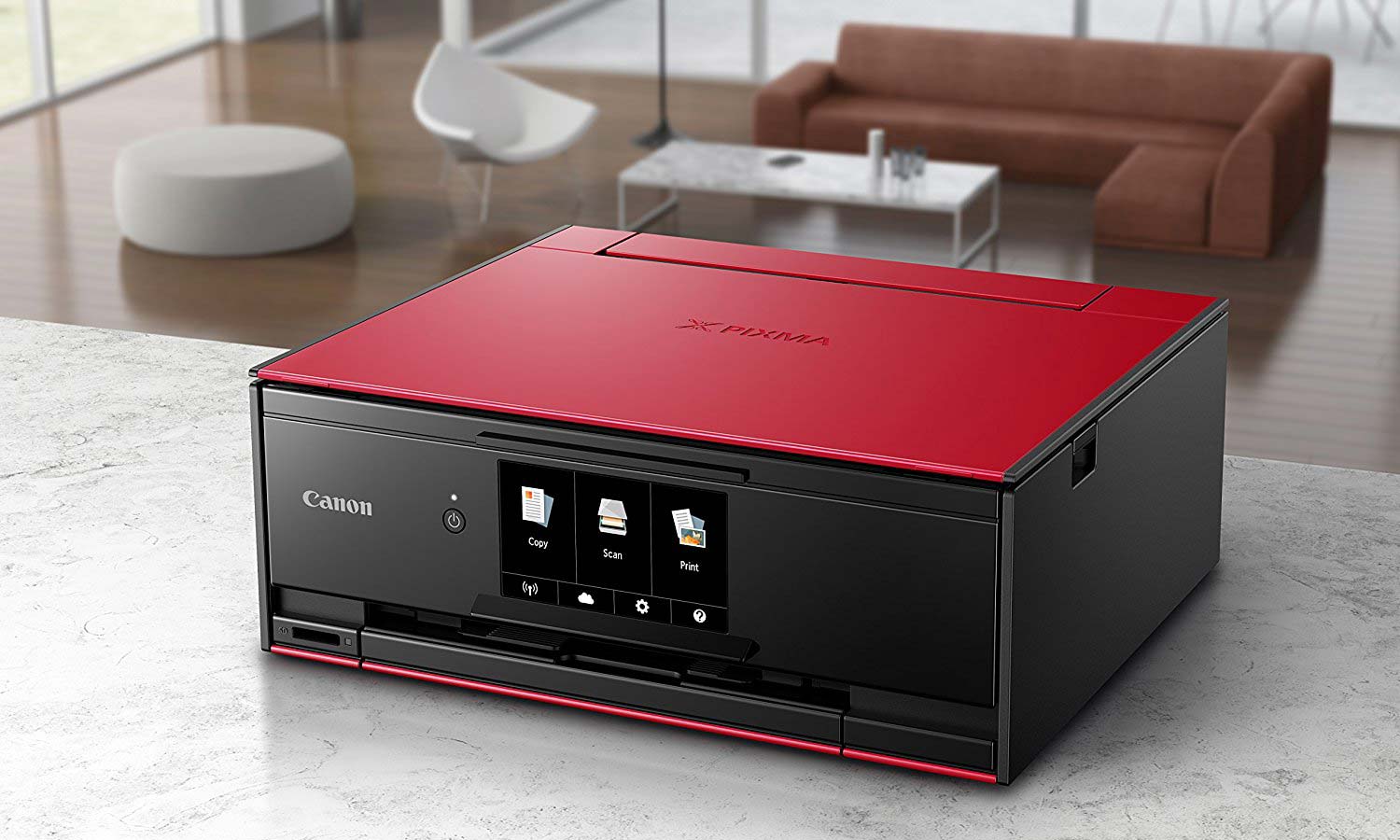Tom's Guide Verdict
The TS9120 delivers excellent performance, high image quality and CD/DVD disc printing capabilities, with average ink costs.
Pros
- +
Fast printing and scanning speeds
- +
Very fast at making color copies
- +
Six individual ink cartridges
- +
Large 5-inch color touch screen
- +
Prints labels onto coated CD/DVD discs
Cons
- -
Estimated ink costs are about average
- -
Paper cassette feels a bit flimsy
- -
Two-sided text-printing speed is about average
Why you can trust Tom's Guide
The Canon Pixma TS9120 is a compact, all-in-one printer that's well-suited to home — and light home-office — duties. At $150, it offers a few more features — and a noteworthy uptick in performance — over its $70 sibling, the Pixma TS5120. One of those features is individual ink cartridges. The TS9120 employs six of them, including two black inks and a photo blue. But the first thing you'll notice is the enormous, 5-inch color touch screen staring at you. Its generous size eases operation, and I found it to be very responsive for stand-alone use. It's the best printer we've tested yet.
Design
The impressive 5-inch color touch screen sits on a panel that hinges upward 90 degrees. All stand-alone operation is done with the touch screen, as there are no physical buttons. This has sometimes been a disappointment on other models whose touch screen was less responsive, but the TS9120's touch screen did not frustrate any of my attempts to change a setting or launch a job task. For example, the Canon TS6020's much more modest 3-inch touch screen was occasionally unresponsive in our testing.
At the bottom left of the front panel is an SD card slot, allowing you to print directly from a memory card without having to use a PC.
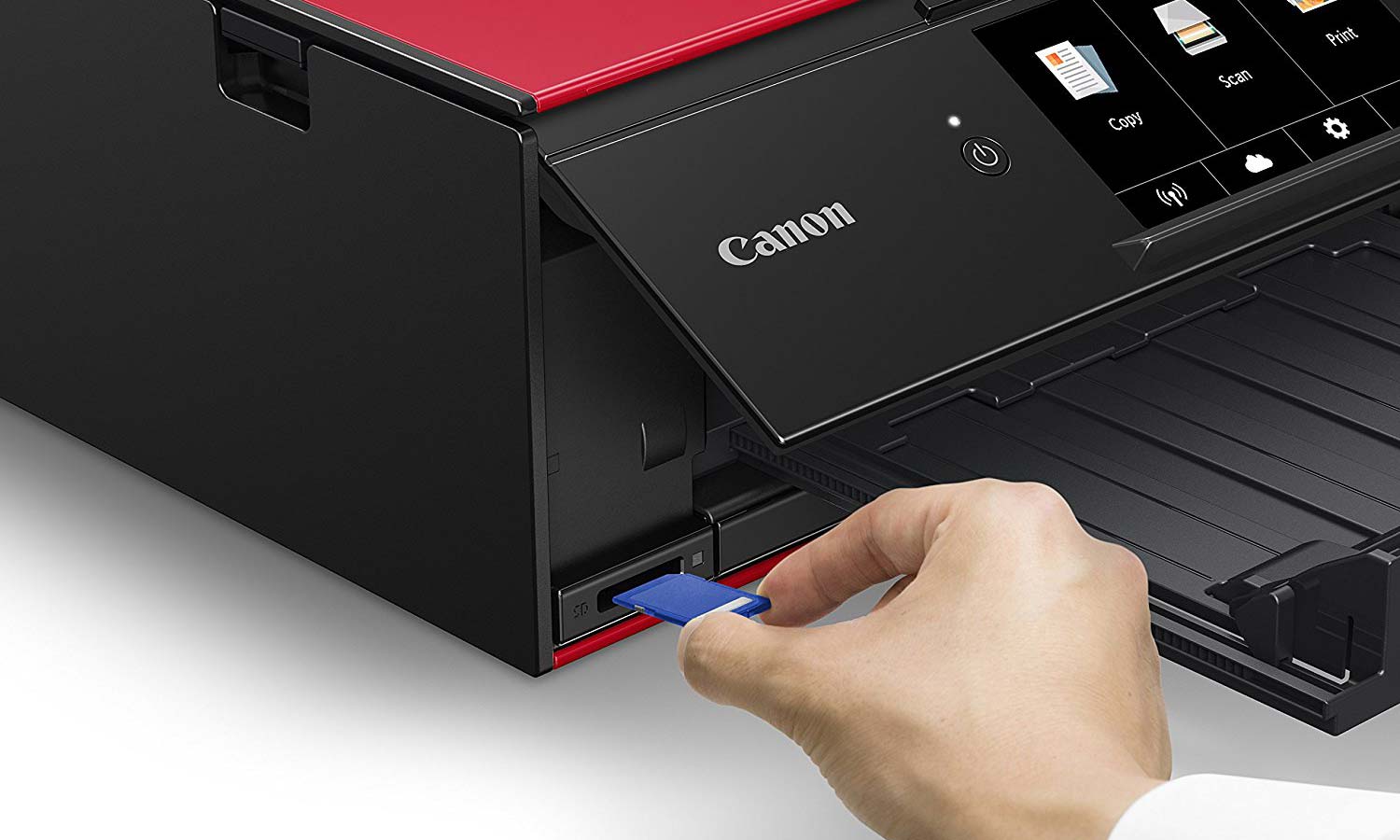
There is a paper cassette on the underside and a vertical paper tray at the back. The output tray sits atop the paper cassette and will automatically extend itself to catch your prints or copies if you forget to do that yourself. Above the output trays is a dedicated CD/DVD disc printing slot; the disc holder slides into the underside of the output tray for storage.
The TS9120 is quite compact, measuring 14.7 (W) x 14.2 (D) x 5.6 (H) inches, with paper installed. Of course, extending the vertical paper tray in the back adds to the height. The main chassis comes in black, and the lid comes in three colors: gray, gold and red.
Print Speed
Get instant access to breaking news, the hottest reviews, great deals and helpful tips.
In testing, the Pixma TS9120 came out of the gate charging and never slowed down, delivering impressive speeds in almost all of our tests. Starting with text printing, the TS9120 is the fastest model we've tested in its class. It printed our text document in just 26.7 seconds, at 11.2 pages per minute, versus the average of 8.4 ppm. By comparison, the TS6020 did so in 30.7 seconds, or 9.8 ppm.
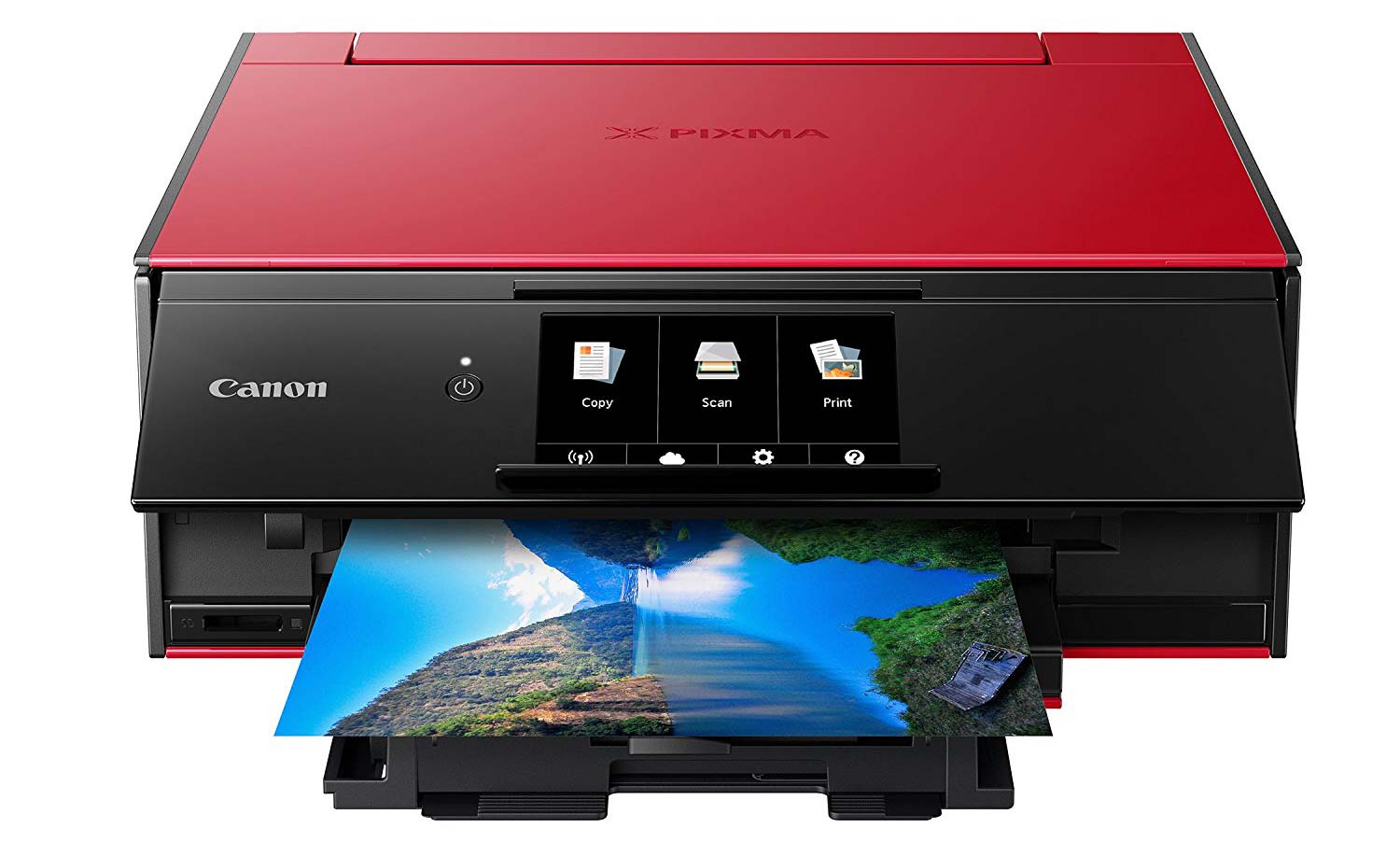
Similarly, the TS9120 printed our six-page color graphics document in just 1 minute and 46 seconds, or 3.4 ppm; this was significantly faster than the 2.5-ppm average. Only the Epson XP-640 was faster, at 1 minute and 11 seconds. The TS6020 printed the same document in just under 2 minutes, or 3.1 ppm.
In testing, the Pixma TS9120 came out of the gate charging and never slowed down, delivering impressive speeds in almost all of our tests.
The TS9120 printed high-resolution photos quickly as well, churning them out at less than half the average time. It made a letter-size glossy print in just 1 minute and 57 seconds, versus the average of 4 minutes and 39 seconds. Only the Canon Pixma TS6020 was faster, by just 3 seconds.
Using the duplexer to make two-sided prints, the TS9120's speed was closer to average. A two-sided, 10-page text document printed in 3 minutes and 12 seconds, which is roughly the 3.1-ppm average. The fastest model, the Epson XP-640, printed the same document in 1 minute and 50 seconds, or 5.5 ppm.
MORE: Best All-in-One Printers
Printing a six-page color document using the duplexer took 2 minutes and 34 seconds (2.3 ppm), which was faster than the average: 198 seconds, or 1.8 ppm. The slowest model at this test, the HP Envy 7855, took 5 minutes and 4 seconds (1.2 ppm).
Copy and Scan Speed
The TS9120 also turned in the fastest time to date at copying a color document, doing so in 17.3 seconds — almost 10 seconds faster than the 27.1-second average. By comparison, the Epson XP-640 took 23 seconds to make the same copy, and the HP Envy 7855 took 24.1 seconds.
Text documents copied faster than average, taking 14 seconds, versus the average of 15.4 seconds. In comparison, the Epson XP-640 took 11.8 seconds. The fastest model to date, the Canon Pixma TS6020, made a text copy in 9.4 seconds.
The TS9120 turned in the fastest time to date at copying a color document, almost 10 seconds faster than the average.
Like color copying, the TS9120 scanned a color photo at 600 dpi faster than any other model, doing so in a brisk 37.8 seconds, versus the average of 1 minute and 6 seconds. The Epson XP-640 was not far behind, at 41.6 seconds, while the HP Envy 7855 was about average, at 1 minute and 10 seconds.
Black-and-white scanning was also quick. The TS9120 made a 300-dpi PDF in 7.7 seconds, versus the average (10.7 seconds). Both the HP Envy 7855 and the Epson XP-640 were noticeably slower, at 14.5 seconds and 16.1 seconds, respectively.
Print Quality
Print quality was high across the board. Text printed with a strong black shade, and letterform edges were generally sharp-looking, though edges looked a little lumpy on close inspection. Graphics printed with attractively saturated colors and lots of detail and smooth textures. It is worth noting that text print quality did not take a hit when the duplexer was used: two-sided prints looked just as good as single-sided prints, for both text and graphics.
Glossy photos printed with lots of fine detail. Colors looked accurate and well-saturated. All in all, it's one of the best photo printers we've seen.
Two-sided prints looked just as good as single-sided prints, both text and graphics.
Copies of text and graphics were generally sharp and attractive. Copying magazine pages produced faithful copies, whether copied in color or black-and-white. Making black-and-white copies of inkjet-printed color graphics, on the other hand, was disappointing, with the printer failing to properly capture midtone transitions.
Scan quality was also very good. The colors of documents and photos were reproduced accurately, and they retained the fine details of the original.
Ink Cost and Yield
Based on our calculations, the TS9120's costs per page are roughly average. Interestingly, In addition to the typical cyan, magenta and yellow ink cartridges, the TS9120 offers three more: a photo blue cartridge and two black ink cartridges (one pigment and one dye-based).
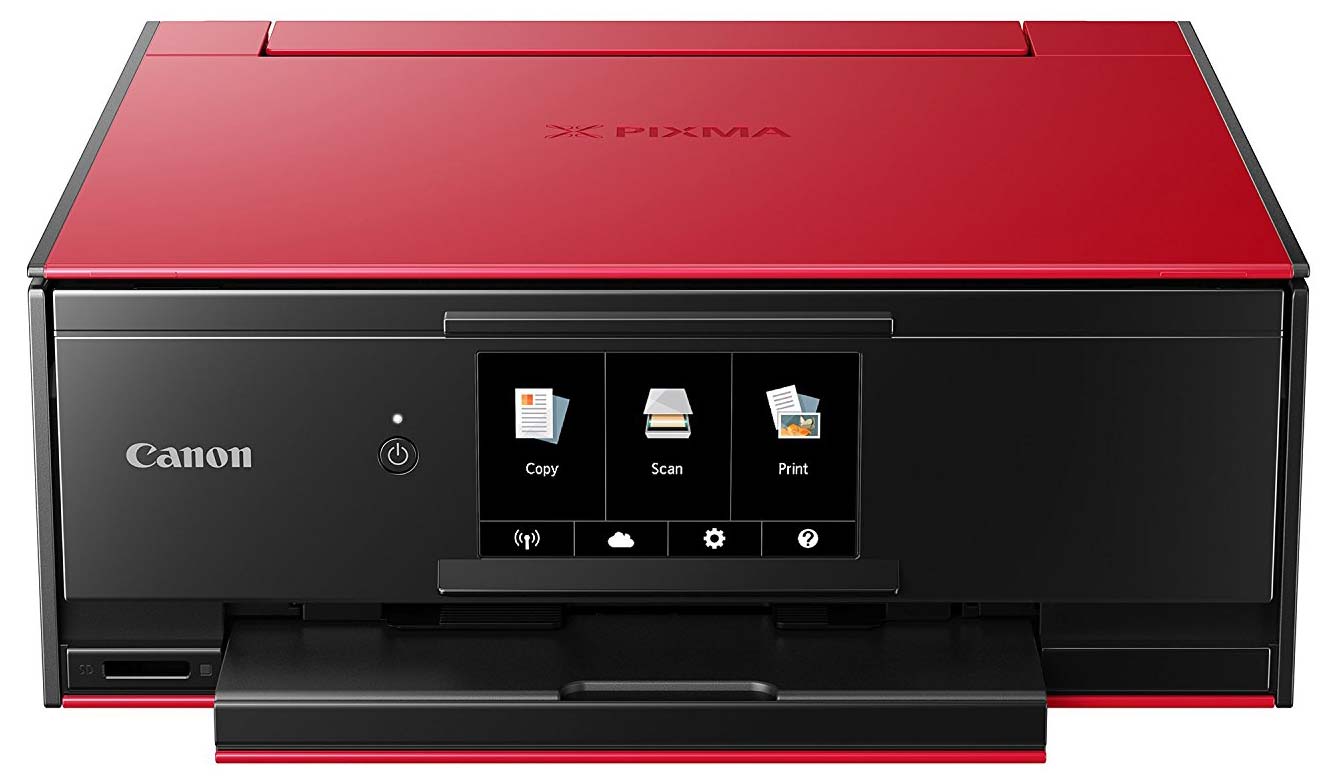
The pigment black is mostly used for printing text documents on plain paper; it is scarcely used on photo paper (the standard-yield cartridge is estimated to be able to print a whopping 1,562 4 x 6-inch photo prints). Similarly, the dye black ink, which is rarely used to print plain-paper documents, will last for an estimated 750 prints.
There are three capacity levels for each cartridge: standard, XL and XXL. In theory, the highest-capacity cartridges will give you the lowest cost per page. But at press time, XXL color cartridges were not yet available.
MORE: How to Add a Printer in Windows 10
For example, at 7.8 cents per text page, the TS9120 bests the HP Envy 7855 (9.5 cents), while the Epson XP-640 is a much better bargain, at 5.8 cents. Using high-yield cartridges, the TS9120 and Envy 7855 cost roughly the same, at 7.1 cents per page, while the Epson XP-640 prints for less than half the cost, at just 3.1 cents. The Pixma TS9120 has XXL black cartridges, which lower text printing costs to 6.4 cents.
Color-printing costs for the TS9120 are 19.8 cents per page when standard cartridges are used, which is below the average estimates (22.4 cents). The HP Envy 7855 costs 24 cents per page, for example, while the cost of the Epson XP-640 comes to 18.8 cents. When high-yield cartridges are used for color prints, however, at 17.2 cents, the TS9120 does not deliver significant savings. Although it bests the Envy 7855 (18 cents), high-yield color costs average 15.4 cents; the Epson XP-640 offers a much better deal at 9.9 cents per page.
Setup and Software
Setting up the TS9120 is a simple matter of removing some packaging tape, installing the ink cartridges and inserting the CD-ROM in your PC, which launches the installation program to provide on-screen prompts. If you don't have a CD/DVD drive, you simply follow the link in the printed quick-start guide to launch the same process. You select a connection, remove a firewall block and perform a print-head alignment. Putting the all-in-one on your wireless network is easy, using the WPS method (you simply press the WPS button on your router when prompted).
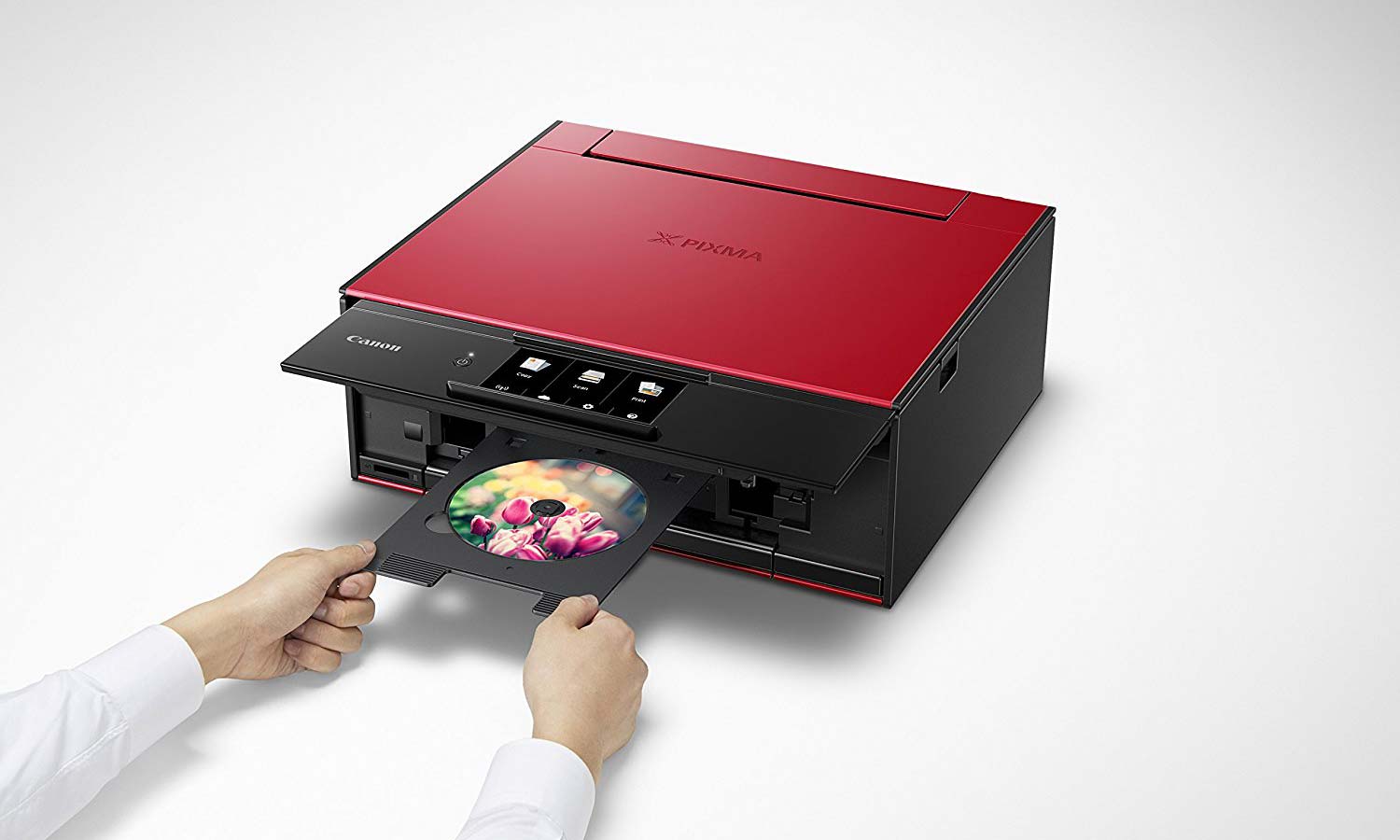
The installation includes software for all functions, including a basic CD/DVD disc printing application for making disc labels. It also includes My Image Garden, a big download you might skip if you're unlikely to use the bulk of the included graphics and templates, its photo organizer or photo editor.
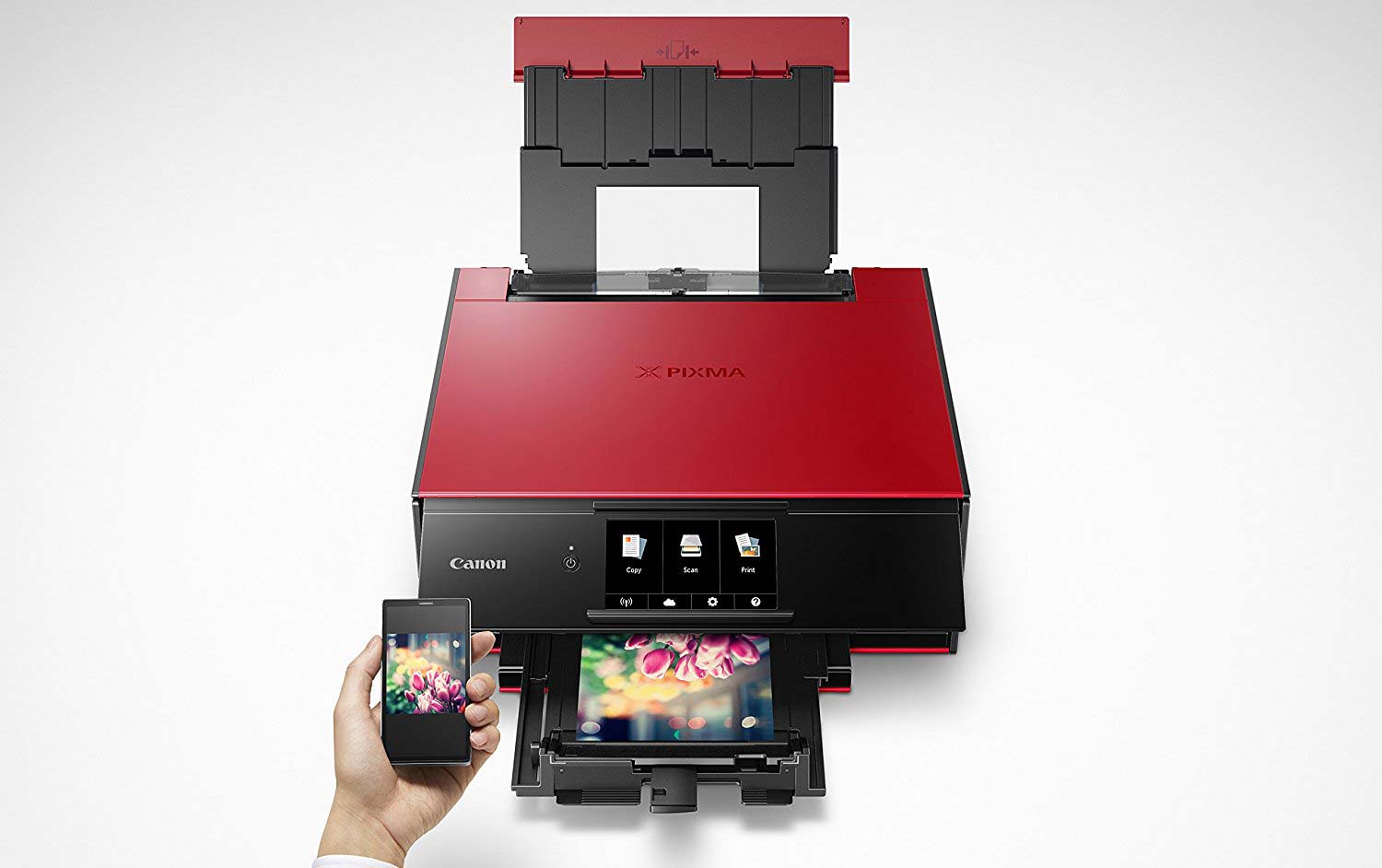
To use the TS9120 with a smart device, install the Canon Print app. For iOS devices, AirPrint is supported. The unit starts up in a brisk 4.7 seconds, significantly faster than the average of 10.7 seconds.
Bottom Line
The Pixma TS9120 offers a lot of bang for the buck. It delivers fast speeds across the board without compromising image quality and does so with six individual ink tanks. It is equally adept at printing, copying and scanning, and the enormous color touch screen makes stand-alone operation a breeze. Estimated ink costs are only average — but that's the only thing average about this little powerhouse.
Compared to the TS6020, the TS9120 offers more features. The first is the large, reliable operation of the touch screen, which shouldn't leave you wishing for physical buttons. Also, you get CD/DVD label printing. The faster scanning speeds are an improvement, and the SD card slot on the front panel offers a convenient way to print photos from your camera's memory card. Between its superb performance and more expansive feature set, the Canon Pixma TS9120 is the clear choice as our top pick for all-around inkjet printing.
Credit: Canon
Eric Butterfield is a freelance writer and musician from California. His work has appeared in PC World magazine, CNET, Taproot, and Alter Action — plus Tom's Guide, of course — while his music has appeared in more than 260 TV show episodes for major networks such as NBC, Hulu, BBC America, and more. You can check out his work on Spotify.
